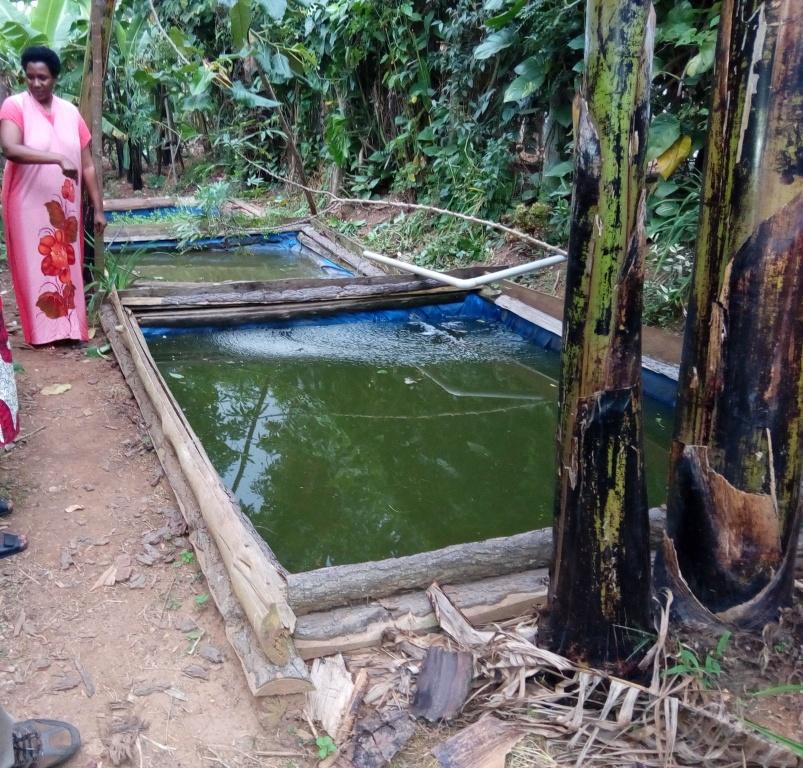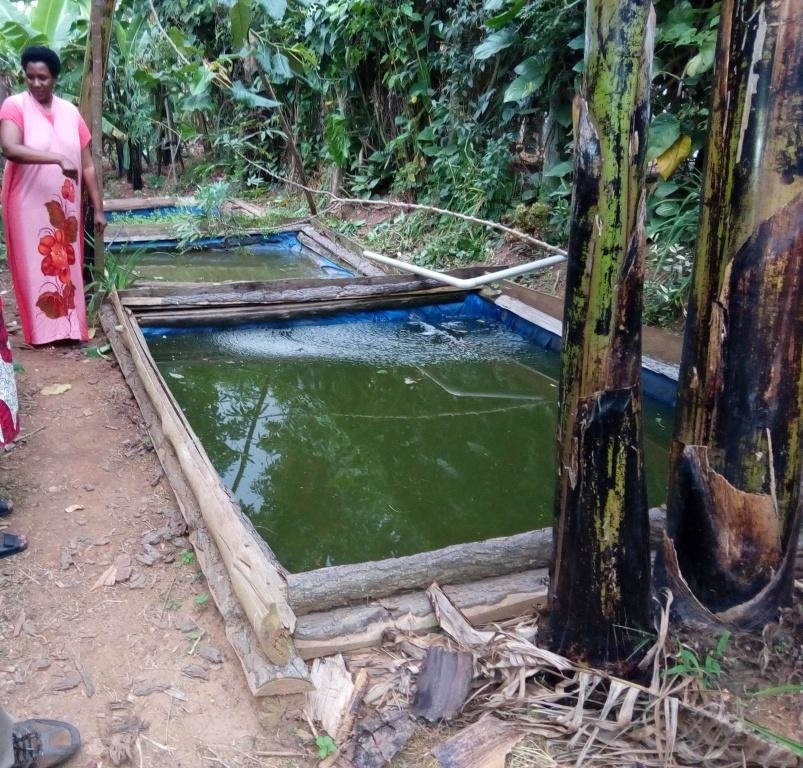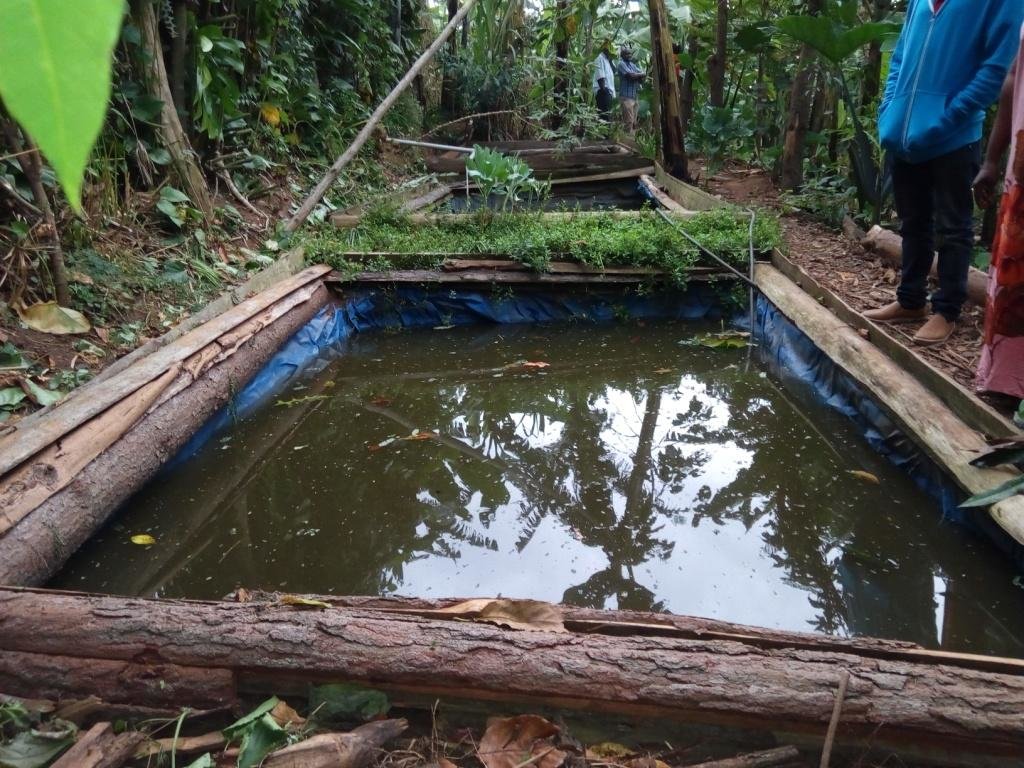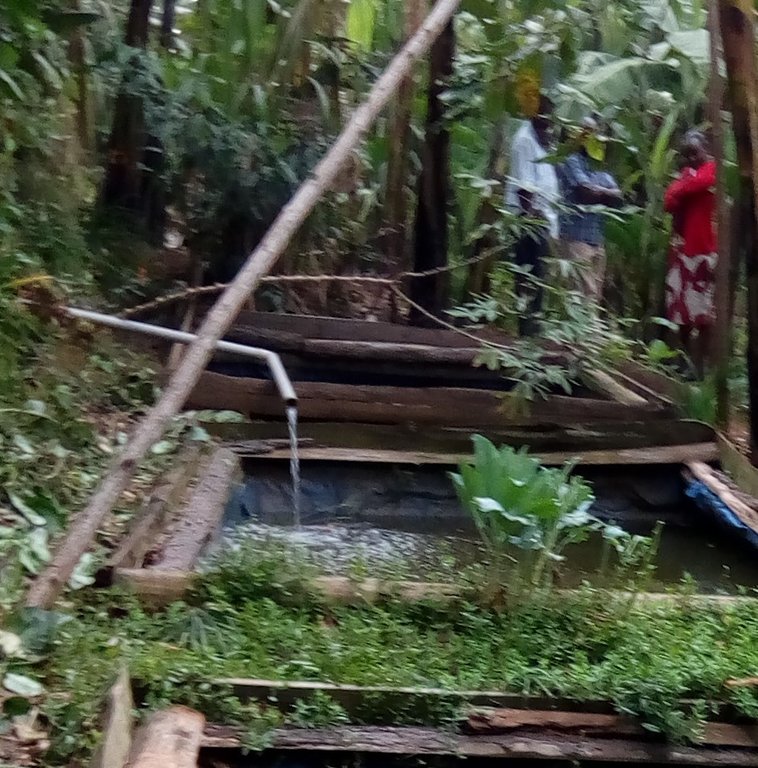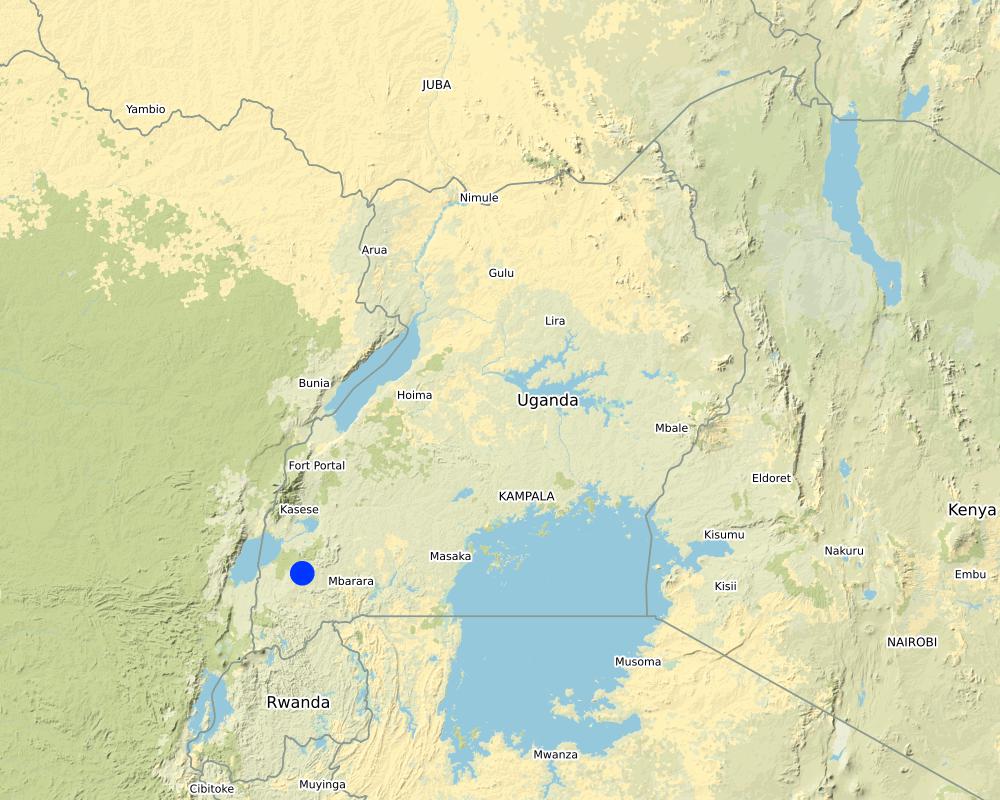Backyard fish farming in tarpaulin ponds for improved livelihood [乌干达]
- 创建:
- 更新:
- 编制者: Aine Amon
- 编辑者: Drake Mubiru, Kamugisha Rick Nelson
- 审查者: Nicole Harari, Udo Höggel
Okutunga Ebyenyanja omu ntundubale
technologies_3391 - 乌干达
查看章节
全部展开 全部收起1. 一般信息
1.2 参与该技术评估和文件编制的资源人员和机构的联系方式
关键资源人
土地使用者:
David Mawanda
Uganda, Bushenyi, Kagoma
乌干达
有助于对技术进行记录/评估的项目名称(如相关)
Scaling-up SLM practices by smallholder farmers (IFAD)有助于对技术进行记录/评估的机构名称(如相关)
National Agricultural Research Organisation (NARO) - 乌干达1.3 关于使用通过WOCAT记录的数据的条件
(现场)数据是什么时候汇编的?:
23/01/2018
编制者和关键资源人员接受有关使用通过WOCAT记录数据的条件。:
是
1.4 所述技术的可持续性声明
这里所描述的技术在土地退化方面是否存在问题,导致无法被认为是一种可持续的土地管理技术?:
否
2. SLM技术的说明
2.1 技术简介
技术定义:
A fish pond for intensive commercial fish farming is constructed in the backyard of the farmer's home for easy management. The pond is lined with a tarpaulin interior and is connected to a water source for water supply during the seasons of water scarcitiy.
2.2 技术的详细说明
说明:
The backyard fish pond farming system is a simple commercial fish farming system established close to the farmers’ home stead. It is planned to ease management of rearing the fish and to minimize maintenance costs. The system is also designed to harvest rain water and overflow which eases filling and emptying of the pond with water. The walls of the ponds are lined with tarpaulin and the banks are strengthened with timber or brick work to prevent breaking of the walls. The three ponds in Bushenyi-Kigoma are located on a gentle slope and designed with a trench that feeds them with rain water from the rain harvest reservoir up slope. They were constructed in 2013 and are located a meter away from a live fence enclosing the farmer’s house. This makes it easy for the farmer to access, monitor and manage the fish ponds.
The establishment process for each pond is simple and may not require technical skills to set up the system. The activities involved include:
i.Excavation of the pond, which is best done during the dry season to avoid interruption by runoff.
ii.Strengthening of banks using timber and nails (some farmers use brinks, cement and sand)
iii.Lining of the water proof tarpaulin on the interior of the pond.
iv.Construction of a water channel from the water reservoir to the pond and fixing of overflow pipes at the deeper end of the ponds.
v.Filling the pond with water and applying animal dug to fertilize the ponds. This creates a favorable environment for growth of microorganisms and algae on which fish can feed.
vi.The fish fingerlings are introduced into the pond two weeks after fertilization with animal dug.
The maintenance activities include; cleaning of ponds from contamination of objects, changing of the pond water on a monthly basis to avoid contamination that may lead to infestation and application of organic fertilizers.
Establishment requires a hoe, panga, dibber, spade, wheel barrow, hammer and the trowel. The inputs include; timber, tarpaulin, cement, garters bricks, sand, nails, plastic pipe, water, animal dung, fish pellets and fish fingerlings. These where used to construct a pond 5 m × 4 m × 3 m i.e length × width × depth respectively, with a maximum carrying capacity of 500 cat fish.
The costs of setting up the system are relatively affordable to the average local people according to the farmer. The key determinants are hiring labor to excavate the ponds, construction of a water channel and stocking fish fingerlings which are all locally available. The maintenance activities involve daily feeding of fish, cleaning in case of contamination, changing the pond water every 3 months and harvesting of fish at 7 months of age. The farmer spends USD $ 164.65 on establishment of the pond system including, exaction costs, equipment, materials and stocking fingerlings (USD $ 0.033 each). The farmer spends USD$ 21.99 on premixed feeds before harvesting the fish after seven months. The cat fish are harvested with 3-5 kg liveweight after 7 months and sold at USD$ 2.75 to wholesale buyers from Kasese District.
The intensive fish farming system is designed to demand minimal labor for feeding the fish, cleaning the pond, replacing water and harvesting fish. The system is also adapted to water scarcity in the dry season since it is connected to a rain water harvest system; regular changing of pond water improves visibility, removes algae, replenishes oxygen and minimizes possible infections in the pond.
2.3 技术照片
2.4 技术视频
注释、简短说明:
The Video shows the set up of the ponds but does not include the farmer's house because of the live fence separating the ponds from the house.
日期:
24/01/2018
摄影师的名字:
Amon Aine
2.5 已应用该技术的、本评估所涵盖的国家/地区/地点
国家:
乌干达
区域/州/省:
Western Uganda, Bushenyi District
有关地点的进一步说明:
Nyabubare Sub county, Kigoma town
注释:
The farm is 6Km from Ishaka Bushenyi along Bushenyi-Rubirizi highway.
Map
×2.6 实施日期
注明实施年份:
2016
2.7 技术介绍
详细说明该技术是如何引入的:
- 通过土地使用者的创新
- 通过项目/外部干预
注释(项目类型等):
Intensive back yard fish farming.
3. SLM技术的分类
3.1 该技术的主要目的
- 改良生产
- 减少、预防、恢复土地退化
- 降低灾害风险
- 适应气候变化/极端天气及其影响
- 创造有益的经济影响
- Beauty
3.2 应用该技术的当前土地利用类型

农田
- 多年一作(非木材)
主要农作物(经济作物及粮食作物):
Bananas, yams and shrub fence
3.3 有关土地利用的更多信息
该技术所应用土地的供水:
- 混合雨水灌溉
注释:
The farmer harvests roof top water and channels it into the ponds during times of water scarcity
每年的生长季节数:
- 2
具体说明:
March - May & Sept - Nov
牲畜密度(如相关):
500 fish per 5m×4m×3m in length, width and depth respectively
3.4 该技术所属的SLM组
- 养蜂、养殖业、家禽业、养兔业、养蚕业等
- 家庭花园
3.5 技术传播
具体说明该技术的分布:
- 适用于特定场所/集中在较小区域
3.6 包含该技术的可持续土地管理措施

结构措施
- S5:大坝、集水斗、水池
3.7 该技术强调的主要土地退化类型

物理性土壤退化
- Pu:由于其他活动而导致生物生产功能的丧失

其它
注释:
The intensive method utilizes small space for high quantity fish production and therefore reduces the conversion of large pieces of land to fish farming
3.8 防止、减少或恢复土地退化
具体数量名该技术与土地退化有关的目标:
- 减少土地退化
注释:
The design promotes intensive methods to utilize small space for high quantity fish production and therefore reduces the conversion of large pieces of land to fish farming.
4. 技术规范、实施活动、投入和成本
4.1 该技术的技术图纸
4.2 技术规范/技术图纸说明
The water ponds are constructed with 5m × 4m × 3 m i.e length × width × depth. The ponds are on a gentle slope a meter away from a live fence. The ponds are lined with a water proof tarpaulin. The banks are strengthened with wood fixed together with nails.
4.3 有关投入和成本计算的一般信息
具体说明成本和投入是如何计算的:
- 每个技术单元
指定单位:
Pond
指定体积、长度等(如果相关):
5m × 4m × 3 m i.e length × width × depth respectively
其它/国家货币(具体说明):
Ugandan shilling
注明美元与当地货币的汇率(如相关):1美元=:
3650.0
注明雇用劳工的每日平均工资成本:
10,000
4.4 技术建立活动
| 活动 | 措施类型 | 时间 | |
|---|---|---|---|
| 1. | Excavation | 结构性的 | In the dry season |
| 2. | Fixing of tarpaulin and timber on the banks | 结构性的 | After excavation |
| 3. | Filling pond with water and fertilizing with animal dug | 管理 | After fixing walls |
| 4. | Stocking the pond | 其它措施 | 2 days after filling pond with water and fertilization |
| 5. | Connecting a water channel from the water reservoir with a pvc pipe at end the end leading to the pond | 结构性的 | After excavation. |
4.5 技术建立所需要的费用和投入
| 对投入进行具体说明 | 单位 | 数量 | 单位成本 | 每项投入的总成本 | 土地使用者承担的成本% | |
|---|---|---|---|---|---|---|
| 劳动力 | Construction labour | man day | 5.0 | 50000.0 | 250000.0 | 100.0 |
| 设备 | Hoe hire | per day | 500.0 | 5.0 | 2500.0 | 100.0 |
| 设备 | Panga hire | per day | 500.0 | 5.0 | 2500.0 | 100.0 |
| 设备 | Spade hire | per day | 500.0 | 5.0 | 2500.0 | 100.0 |
| 设备 | Hammer hire | per day | 500.0 | 5.0 | 2500.0 | 100.0 |
| 设备 | Wheel barrow hire | per day | 500.0 | 5.0 | 2500.0 | 100.0 |
| 设备 | Metallic tray | per day | 500.0 | 5.0 | 2500.0 | 100.0 |
| 植物材料 | Fish fingerlings | pieces | 500.0 | 500.0 | 250000.0 | 100.0 |
| 肥料和杀菌剂 | Animal Dung | kg | 50.0 | 120.0 | 6000.0 | 100.0 |
| 施工材料 | Tarpaulin | pieces | 1.0 | 45000.0 | 45000.0 | 100.0 |
| 施工材料 | Timber | pieces | 8.0 | 3000.0 | 24000.0 | 100.0 |
| 施工材料 | Nails | Kg | 0.5 | 8000.0 | 4000.0 | 100.0 |
| 施工材料 | Hose Pipe | Pieces | 2.0 | 5000.0 | 10000.0 | 100.0 |
| 其它 | Water | Liters | 500.0 | 10.0 | 5000.0 | 100.0 |
| 技术建立所需总成本 | 609000.0 | |||||
4.6 维护/经常性活动
| 活动 | 措施类型 | 时间/频率 | |
|---|---|---|---|
| 1. | Feeding | 管理 | Once daily |
| 2. | Cleaning | 管理 | Once a week |
| 3. | Changing the water | 管理 | Every three months |
| 4. | Harvesting | 管理 | Every 7months |
4.7 维护/经常性活动所需要的费用和投入(每年)
| 对投入进行具体说明 | 单位 | 数量 | 单位成本 | 每项投入的总成本 | 土地使用者承担的成本% | |
|---|---|---|---|---|---|---|
| 劳动力 | Cleaning | man day | 1.0 | 5000.0 | 5000.0 | 100.0 |
| 劳动力 | Feeding | man day | 1.0 | 600000.0 | 600000.0 | 100.0 |
| 劳动力 | Replacement of water | man day | 1.0 | 100000.0 | 100000.0 | 100.0 |
| 劳动力 | Harvesting | manday | 2.0 | 5000.0 | 10000.0 | 100.0 |
| 设备 | Slasher | piece | 2.0 | 8000.0 | 16000.0 | 100.0 |
| 设备 | Hoe | piece | 2.0 | 15000.0 | 30000.0 | 100.0 |
| 设备 | Bucket | piece | 2.0 | 6000.0 | 12000.0 | 100.0 |
| 肥料和杀菌剂 | Cow dug | tones | 1.0 | 250000.0 | 250000.0 | 100.0 |
| 技术维护所需总成本 | 1023000.0 | |||||
4.8 影响成本的最重要因素
描述影响成本的最决定性因素:
Excavation of ponds and stocking of fish fingerlings. Excavation is done once at the start of the project. The labour required for operation and maintenance is minimal compared to conventional fish farming methods.
5. 自然和人文环境
5.1 气候
年降雨量
- < 250毫米
- 251-500毫米
- 501-750毫米
- 751-1,000毫米
- 1,001-1,500毫米
- 1,501-2,000毫米
- 2,001-3,000毫米
- 3,001-4,000毫米
- > 4,000毫米
有关降雨的规范/注释:
The rain seasons are two i.e March-May, Sept-ov
农业气候带
- 半湿润
5.2 地形
平均坡度:
- 水平(0-2%)
- 缓降(3-5%)
- 平缓(6-10%)
- 滚坡(11-15%)
- 崎岖(16-30%)
- 陡峭(31-60%)
- 非常陡峭(>60%)
地形:
- 高原/平原
- 山脊
- 山坡
- 山地斜坡
- 麓坡
- 谷底
垂直分布带:
- 0-100 m a.s.l.
- 101-500 m a.s.l.
- 501-1,000 m a.s.l.
- 1,001-1,500 m a.s.l.
- 1,501-2,000 m a.s.l.
- 2,001-2,500 m a.s.l.
- 2,501-3,000 m a.s.l.
- 3,001-4,000 m a.s.l.
- > 4,000 m a.s.l.
说明该技术是否专门应用于:
- 不相关
5.3 土壤
平均土层深度:
- 非常浅(0-20厘米)
- 浅(21-50厘米)
- 中等深度(51-80厘米)
- 深(81-120厘米)
- 非常深(> 120厘米)
土壤质地(表土):
- 中粒(壤土、粉土)
土壤质地(地表以下> 20厘米):
- 中粒(壤土、粉土)
表土有机质:
- 中(1-3%)
5.4 水资源可用性和质量
地下水位表:
5-50米
地表水的可用性:
中等
水质(未处理):
不良饮用水(需要处理)
水的盐度有问题吗?:
是
具体说明:
Cat fish doesn't thrive well in saline waters, the longer the water stays in the pond the more salts it accumulates due to waste from fish and feeds being used hence need for replacement every three months.
该区域正在发生洪水吗?:
否
5.5 生物多样性
物种多样性:
- 高
栖息地多样性:
- 中等
5.6 应用该技术的土地使用者的特征
定栖或游牧:
- 定栖的
生产系统的市场定位:
- 商业/市场
非农收入:
- 收入的10-50%
相对财富水平:
- 丰富
个人或集体:
- 个人/家庭
机械化水平:
- 手工作业
性别:
- 男人
土地使用者的年龄:
- 中年人
说明土地使用者的其他有关特征:
The project belongs to a household of 5 children and parents in their 45-50 years
5.7 应用该技术的土地使用者拥有或租用的平均土地面积
- < 0.5 公顷
- 0.5-1 公顷
- 1-2 公顷
- 2-5公顷
- 5-15公顷
- 15-50公顷
- 50-100公顷
- 100-500公顷
- 500-1,000公顷
- 1,000-10,000公顷
- > 10,000公顷
这被认为是小规模、中规模还是大规模的(参照当地实际情况)?:
- 中等规模的
5.8 土地所有权、土地使用权和水使用权
土地所有权:
- 州
- 个人,有命名
土地使用权:
- 个人
用水权:
- 社区(有组织)
- 个人
5.9 进入服务和基础设施的通道
健康:
- 贫瘠
- 适度的
- 好
教育:
- 贫瘠
- 适度的
- 好
技术援助:
- 贫瘠
- 适度的
- 好
就业(例如非农):
- 贫瘠
- 适度的
- 好
市场:
- 贫瘠
- 适度的
- 好
能源:
- 贫瘠
- 适度的
- 好
道路和交通:
- 贫瘠
- 适度的
- 好
饮用水和卫生设施:
- 贫瘠
- 适度的
- 好
金融服务:
- 贫瘠
- 适度的
- 好
6. 影响和结论性说明
6.1 该技术的现场影响
社会经济效应
生产
作物生产
注释/具体说明:
Water from pond used for irrigation
收入和成本
农业投入费用
注释/具体说明:
Less labour cots for the operation & maintenance
农业收入
收入来源的多样性
注释/具体说明:
Farmer has many other projects (piggery, bananas, yams)
生态影响
水循环/径流
水的回收/收集
注释/具体说明:
Water collected in ponds
地表径流
土壤
土壤水分
土壤覆盖层
土壤流失
减少气候和灾害风险
洪水影响
干旱影响
6.2 该技术的场外影响已经显现
水资源可用性
注释/具体说明:
Harvesting of water for fish farming reduces the runoff and hence a reduction in the water volumes flowing down hill
对邻近农田的破坏
6.3 技术对渐变气候以及与气候相关的极端情况/灾害的暴露和敏感性(土地使用者认为的极端情况/灾害)
气候有关的极端情况(灾害)
气候灾害
| 该技术是如何应对的? | |
|---|---|
| 干旱 | 非常好 |
注释:
During the dry season, the water harvested from the roof top is used to replenish the water in the ponds
6.4 成本效益分析
技术收益与技术建立成本相比如何(从土地使用者的角度看)?
短期回报:
积极
长期回报:
积极
技术收益与技术维护成本/经常性成本相比如何(从土地使用者的角度看)?
短期回报:
积极
长期回报:
非常积极
6.5 技术采用
- 10-50%
在所有采用这项技术的人当中,有多少人是自发地采用该技术,即未获得任何物质奖励/付款?:
- 50-90%
6.6 适应
最近是否对该技术进行了修改以适应不断变化的条件?:
是
若是,说明它适应了哪些变化的条件:
- 劳动力可用性(例如,由于迁移)
具体说明技术的适应性(设计、材料/品种等):
The system is designed to harvest water on roof tops and deliver it in the fishponds, Some of the harvested water is reserved for replenishing of water in the ponds during times of scarcity
6.7 该技术的优点/长处/机会
| 土地使用者眼中的长处/优势/机会 |
|---|
| Easy management since most of the tedious work is at establishment |
| Easy to harvest the fish since many fish are keep in a small pond/tarpaulin |
| 编制者或其他关键资源人员认为的长处/优势/机会 |
|---|
| There is rady market for the fish |
| Rain Water harvesting reduces impacts of climate change on the fish production especially in the dry season/times of scarcity |
| Source of proteins for the public that buy the fish for sauce |
6.8 技术的弱点/缺点/风险及其克服方法
| 土地使用者认为的弱点/缺点/风险 | 如何克服它们? |
|---|---|
| At times of extreme dry season, the farmer may face challenges of water scarcity | Establishment of big enough water reservoirs |
| 编制者或其他关键资源人员认为的弱点/缺点/风险 | 如何克服它们? |
|---|---|
| Due to high stock ratio, the fish are prone to diseases/parasites in case of any break out | Reduction in the stocking rate, the farmer should farther maintain the hygiene and precaution in management |
7. 参考和链接
7.1 信息的方法/来源
- 实地考察、实地调查
1 farm
- 与土地使用者的访谈
1 farmer
- 根据报告和其他现有文档进行编译
1- a news paper that wrote about a similar pond system, in Masaka District
7.3 链接到网络上可用的相关信息
标题/说明:
Rear fish in your backyard with harvested rainwater
URL:
http://www.monitor.co.ug/Magazines/Farming/Rear-fish-backyard-harvested-rainwater/689860-2997914-vacgkk/index.html
链接和模块
全部展开 全部收起链接
无链接
模块
无模块


